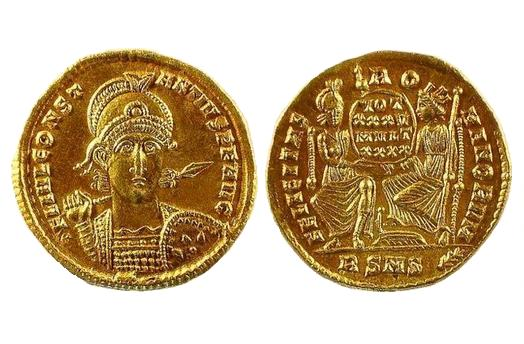
about ancient nomos
Ancient Nomos Art is a museum of galleries exhibiting ancient coins and ancient mint maps. The coin gallery displays the diverse art and history of hand-crafted ancient Greek, Roman, Byzantine, Persian and Medieval coinage. The ancient mints mapping gallery features Greek, Roman, Byzantine, Asia Minor and Medieval mint city regions and territories. Visitor's are welcome to explore, study and enjoy Ancient Nomos Art.

Imperial, Roman – 357 AD
Constantius II
From Ancient Galleries

Obverse: Emperor Constantius II facing, helmeted, cuirassed, spear over right.
Reverse: Enthroned Roma left facing and Constantinoplis on right facing left, holding sceptre and resting right foot on prow, both holding inscribed shield.
LEGEND
Obv: FL IVL CONSTANTIVS P F AVG, Helmeted and cuirassed bust of Constantius II, three-quarter facing Rev: FELICITAS ROMANORVM, Roma on left, Constantinopolis on right, shield inscribed VOT / XXXV / MVLT / XXXX, in exergue below RSMS.
The Roman emperor Constantius II was the second son of Constantine the Great. Born Flavius Julius Valerius in 317 AD, Constantius II ruled approximately 34 years. Upon the death of his father, Constantine the Great, Constantius II was given rule over eastern Asia Minor, while his two brothers, Constans I and Constantine II, received the western portions. His power grew after several successful onslaughts against the Persians. When the Western Empire became disrupted after the murder of his brother Constans I in 350 AD, Constantius II assumed control, relocated and defeated the usurping Roman commander Magnentius the German. Constantius II was now sole Roman emperor. Afterwards, he delegated much of his power to his cousin Julian the Apostate in Gaul. His obverse gold coins are known for there glorious military style depicting the emperor three-quarter facing with helmet, cuirassed and holding a decorated shield with a spear in his right hand. His obverse appearance was a tradition used by the emperors of the early Byzantine rulers such as Justinian I. The solidus reverse depicts the subtle unequal sharing of power between Roma and her new city Constantinopolis. Constantinopolis is seated to the left and faces Roma, with her right foot on the ships prow, commanding direction. She is crowned while Roma is helmeted. The iconography appears to simultaneously recognize the new power of Constantinopolis, while also depicting a union with older Roma, as the two cities each support the inscribed shield. As Roman Christianity develops into the fourth century, these two reverse figures would be transformed into angels. At the time this coin was struck, the two figures were still depicted as personifications of the two cities. Constantius I died during a Persian campaign near Cilicia in 361 AD and Julian I became his successor.
DOCUMENTATION
Value: Solidus. Metal: AV Gold. Weight: 4.50 grams. Mint: Rome. Date: struck 357 AD.
Attribution: RIC 296; Dumbarton Oaks Collection, 90 officina variety; Depeyrot 15; NFA XII, 448; McLendon 214 (this coin).
Legend, Documentation and Attribution
